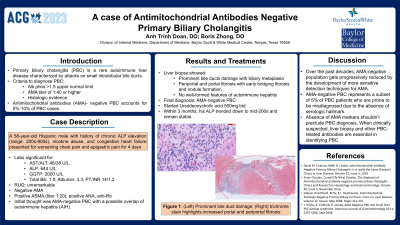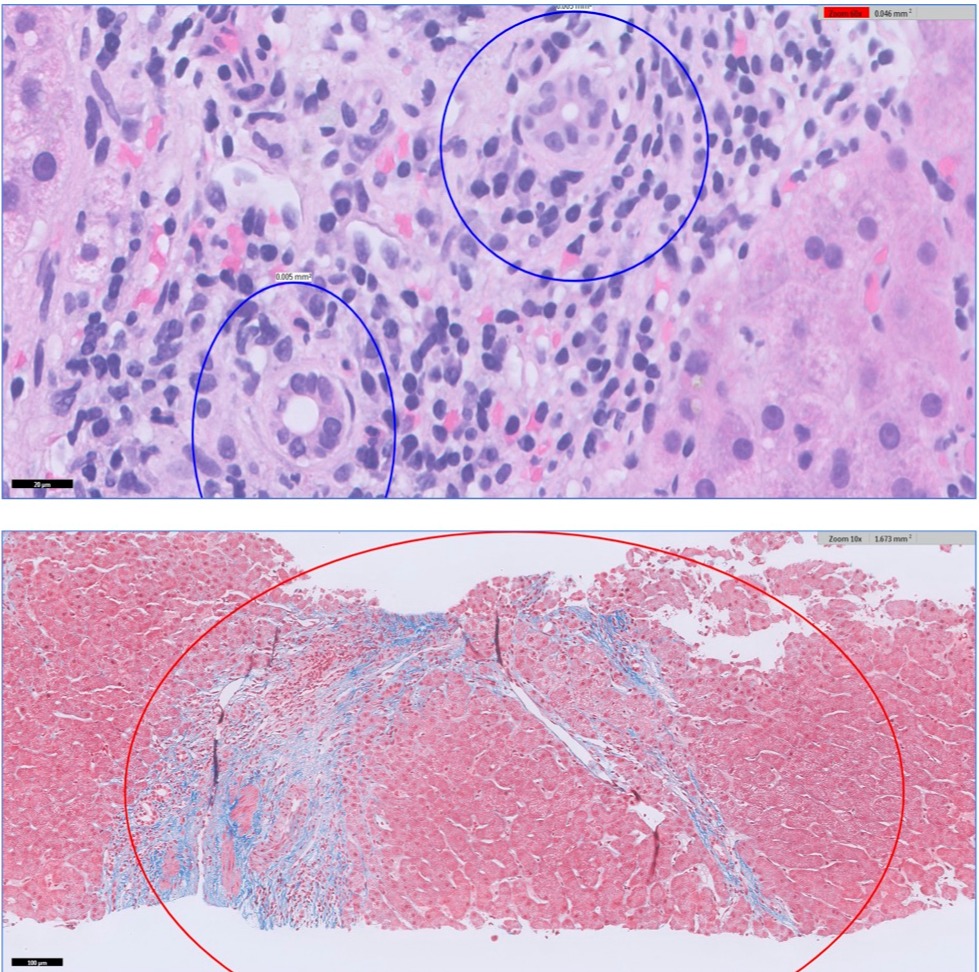Tuesday Poster Session
Category: Biliary/Pancreas
P2994 - A Case of Antimitochondrial Antibodies - Negative Primary Biliary Cholangitis
Tuesday, October 24, 2023
10:30 AM - 4:00 PM PT
Location: Exhibit Hall

Has Audio

Anh Trinh Doan, DO
Baylor Scott & White
Belton, TX
Presenting Author(s)
Anh Trinh Doan, DO1, Boris Zhong, DO2
1Baylor Scott & White, Belton, TX; 2Baylor Scott & White, Temple, TX
Introduction: Primary biliary cholangitis (PBC) is a rare autoimmune liver disease characterized by attacks on small intralobular bile ducts. Antimitochondrial antibodies (AMA) have been established as a serologic hallmark of PBC, as it presents in approximately 95% of all cases. Here, we report a patient with clinical and histologic evidence of PBC, with undetectable AMA.
Case Description/Methods: A 58-year-old Hispanic male patient with CHF and chronic elevated ALP presented with worsening chest pain and epigastric pain for four days. At admission, patient’s liver profile showed ALP 644 U/L, AST 46 U/L, ALT 38 U/L, Tbili 0.9 mg/dL and GGTP 200U/L. Imaging showed enterocolitis and an unremarkable liver. Further labs revealed negative AMA, positive repeated ASMA (titer 1:20), positive ANA, positive anti-Ro, IgG: 1722, and IgA: 804. These findings gave concern for Primary Biliary Sclerosis (PBC) and ursodiol was initiated. A subsequent liver biopsy displayed prominent bile ducts damage (Figure 1); periportal, and portal fibrosis with early bridging fibrosis and nodule formation (Figure 2), most compatible with PBC. Well-formed features of Autoimmune hepatitis were not seen.
Patient was started on Ursodeoxycholic acid 500mg twice a day. Within three months, his ALP trended down to mid 200s.
Discussion: PBC diagnosis requires two out of three criteria, including positive AMA, elevated ALP, and histologic evidence in a biopsy. AMA-negative PBC represents a subset of 5% of PBC patients, who are prone to be misdiagnosed due to the absence of serologic hallmark. There are no clinical spectrum or treatment differences dependent on detection of AMA. Recently, more sensitive assays have detected presence of AMA in patients who were negative on standard testing, further blurring the distinction between the two populations. Interestingly, majority of the newly detected AMA-positive patients were also positive for ANA and other PBC-specific antibodies like anti-gp210 or anti-sp100. Hence, absence of AMA markers should not preclude PBC diagnosis. When clinically suspected, liver biopsy and other PBC-related antibodies are important for PBC evaluation. Our case highlights the rare subset of AMA-negative patients that have histopathology consistent with PBC.

Disclosures:
Anh Trinh Doan, DO1, Boris Zhong, DO2. P2994 - A Case of Antimitochondrial Antibodies - Negative Primary Biliary Cholangitis, ACG 2023 Annual Scientific Meeting Abstracts. Vancouver, BC, Canada: American College of Gastroenterology.
1Baylor Scott & White, Belton, TX; 2Baylor Scott & White, Temple, TX
Introduction: Primary biliary cholangitis (PBC) is a rare autoimmune liver disease characterized by attacks on small intralobular bile ducts. Antimitochondrial antibodies (AMA) have been established as a serologic hallmark of PBC, as it presents in approximately 95% of all cases. Here, we report a patient with clinical and histologic evidence of PBC, with undetectable AMA.
Case Description/Methods: A 58-year-old Hispanic male patient with CHF and chronic elevated ALP presented with worsening chest pain and epigastric pain for four days. At admission, patient’s liver profile showed ALP 644 U/L, AST 46 U/L, ALT 38 U/L, Tbili 0.9 mg/dL and GGTP 200U/L. Imaging showed enterocolitis and an unremarkable liver. Further labs revealed negative AMA, positive repeated ASMA (titer 1:20), positive ANA, positive anti-Ro, IgG: 1722, and IgA: 804. These findings gave concern for Primary Biliary Sclerosis (PBC) and ursodiol was initiated. A subsequent liver biopsy displayed prominent bile ducts damage (Figure 1); periportal, and portal fibrosis with early bridging fibrosis and nodule formation (Figure 2), most compatible with PBC. Well-formed features of Autoimmune hepatitis were not seen.
Patient was started on Ursodeoxycholic acid 500mg twice a day. Within three months, his ALP trended down to mid 200s.
Discussion: PBC diagnosis requires two out of three criteria, including positive AMA, elevated ALP, and histologic evidence in a biopsy. AMA-negative PBC represents a subset of 5% of PBC patients, who are prone to be misdiagnosed due to the absence of serologic hallmark. There are no clinical spectrum or treatment differences dependent on detection of AMA. Recently, more sensitive assays have detected presence of AMA in patients who were negative on standard testing, further blurring the distinction between the two populations. Interestingly, majority of the newly detected AMA-positive patients were also positive for ANA and other PBC-specific antibodies like anti-gp210 or anti-sp100. Hence, absence of AMA markers should not preclude PBC diagnosis. When clinically suspected, liver biopsy and other PBC-related antibodies are important for PBC evaluation. Our case highlights the rare subset of AMA-negative patients that have histopathology consistent with PBC.

Figure: Figure 1 (top image): prominent bile ducts damage
Figure 2 (bottom image): Trichrome stain highlights increased portal and periportal fibrosis.
Figure 2 (bottom image): Trichrome stain highlights increased portal and periportal fibrosis.
Disclosures:
Anh Trinh Doan indicated no relevant financial relationships.
Boris Zhong indicated no relevant financial relationships.
Anh Trinh Doan, DO1, Boris Zhong, DO2. P2994 - A Case of Antimitochondrial Antibodies - Negative Primary Biliary Cholangitis, ACG 2023 Annual Scientific Meeting Abstracts. Vancouver, BC, Canada: American College of Gastroenterology.
